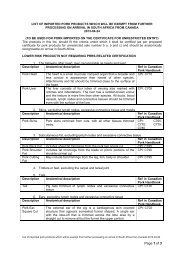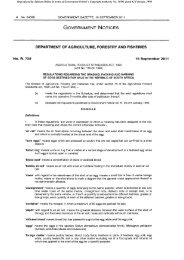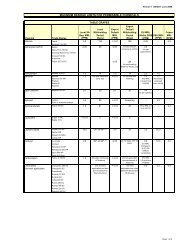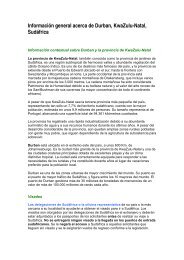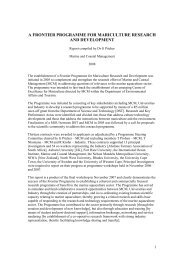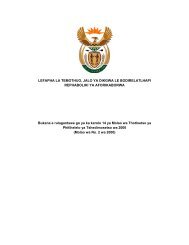You also want an ePaper? Increase the reach of your titles
YUMPU automatically turns print PDFs into web optimized ePapers that Google loves.
C<br />
rabs, like all arthropods, have a hard external<br />
skeleton with joints to allow movement.<br />
Arthropods include insects and spiders, which are<br />
abundant on land but are scarcely represented in<br />
the sea. Crustaceans are by far the most diverse<br />
group of arthropods in the sea, and include crabs,<br />
lobsters, shrimps, and barnacles. Their bodies are<br />
usually made up of a fused head and thorax and a<br />
separate abdomen. In crabs the abdomen does not<br />
form a tail (like that of the rock lobster) but is<br />
tucked beneath the chest. The head and thorax are<br />
covered by a shield-like carapace, which houses the<br />
gills. Crabs are bilaterally symmetrical with five<br />
pairs of walking legs the first of which form large<br />
nippers. They run sideways to increase their stride<br />
without entangling their long legs. Because the<br />
exoskeleton cannot expand, crabs periodically<br />
shed it (a process called moulting) and can<br />
rapidly grow before the new shell hardens. Many<br />
crustaceans have the ability to voluntarily shed<br />
limbs (autotomy), if a limb is grabbed by a pre d a t o r.<br />
Lost limbs can regenerate over the next few<br />
moults. Crabs have two pairs of antennae and<br />
well-developed stalked eyes that can be folded<br />
down into protective grooves.<br />
Ghost crab<br />
Fiddler crab<br />
abdomen<br />
C O A S TA L A N D M A R I N E L I F E – A N I M A L S : I N V E RT E B R A T E S – C R U S T A C E A N S<br />
Crabs 3B<br />
Feeding<br />
Most crabs are scavengers or carnivores. They use their<br />
nippers for capturing and holding prey. Their mouths are<br />
surrounded by a basket of small, hairy limbs that help to<br />
manipulate the food and prevent it from being washed away<br />
while a pair of strong mandibles do the chewing. A few species<br />
filter food particles from the water using their antennae, for<br />
example the masked crab and the mole crab.<br />
Reproduction and life cycle<br />
Some crabs show elaborate courtship behaviour. Males and<br />
females may differ in their colouring and nipper sizes and the<br />
female has a broader abdomen than the male. Fertilisation is<br />
internal: sperm from the male’s genital pores on the base of<br />
the fifth legs is transferred through tubular appendages to the<br />
female genital pores on the bases of her third legs. The eggs<br />
are brooded beneath the abdomen of the female and hatch<br />
into characteristic zoeae larvae that float in the sea. The zoea<br />
larva has a long spine on its back. It metamorphoses into a<br />
swimming megalopa larva that is more like a crab but has a<br />
tail. It settles down to become a miniature adult.<br />
Brachyura – True crabs<br />
The true crabs are amongst the best known marine animals<br />
and are remarkably successful in occupying practically every<br />
marine habitat. They are characterised by the reduced but<br />
segmented abdomen tucked beneath the chest and the front<br />
legs that bear nippers. There are over 300 species in South<br />
Africa, mainly along the south and east coasts.<br />
nippers<br />
Xanthid crab<br />
Swimming crab Sponge crab





